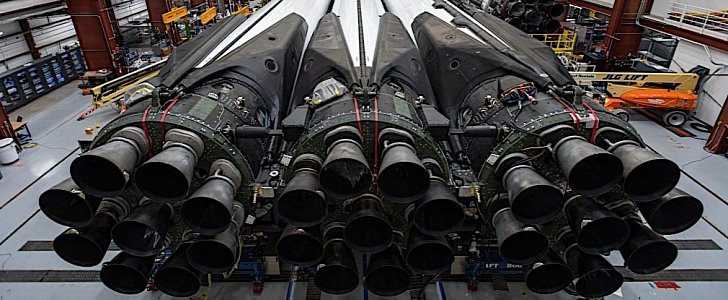27 Merlin engines linked together in groups of nine make for the most powerful operational rocket in the world, the Falcon Heavy. And they also look amazing.
Over the weekend, preparations for the rocket’s second ever launch into space continued in a hangar near the Launch Complex 39A, and this time SpaceX decided to give the world a sneak peek into how the monstrous machine comes together.
Elon Musk’s star reusable launch system comprises three Falcon 9 nine-engine cores capable of generating more than 5 million pounds of thrust at liftoff. In the time-lapse video released over the weekend, we get to see how the three cores come together while horizontal in the hangar, through a procedure called mating.
After the procedure concluded in the hangar, the rocket was rolled onto the pad for a static test fire ahead of the launch of the Arabsat 6A satellite on April 9.
“Static fire of Falcon Heavy complete—targeting April 9 launch of Arabsat-6A from Launch Complex 39A in Florida,” tweeted SpaceX.
All the engines that you see in the video below are called Stage 1. The side cores are connected at the base and the top of the center core’s liquid oxygen tank. After liftoff, those boosters will separate. The second stage, the one that actually gets the cargo into orbit, comprises a Falcon 9-sourced Merlin engine.
The only time the Falcon Heavy flew until this week was in February 2018, when alongside a variety of other cargo the rocket carried a Tesla Roadster to space.
The fate of the Roadster is unknown at this point. Having been launched with no particular target in mind, the car will spin aimlessly around the Solar System until it meets its demise.
The Arabsat 6A that will depart Earth this week, on the other hand, will stick around in orbit, providing Ku-band and Ka-band communications coverage for the Middle East, North and South Africa.
Elon Musk’s star reusable launch system comprises three Falcon 9 nine-engine cores capable of generating more than 5 million pounds of thrust at liftoff. In the time-lapse video released over the weekend, we get to see how the three cores come together while horizontal in the hangar, through a procedure called mating.
After the procedure concluded in the hangar, the rocket was rolled onto the pad for a static test fire ahead of the launch of the Arabsat 6A satellite on April 9.
“Static fire of Falcon Heavy complete—targeting April 9 launch of Arabsat-6A from Launch Complex 39A in Florida,” tweeted SpaceX.
All the engines that you see in the video below are called Stage 1. The side cores are connected at the base and the top of the center core’s liquid oxygen tank. After liftoff, those boosters will separate. The second stage, the one that actually gets the cargo into orbit, comprises a Falcon 9-sourced Merlin engine.
The only time the Falcon Heavy flew until this week was in February 2018, when alongside a variety of other cargo the rocket carried a Tesla Roadster to space.
The fate of the Roadster is unknown at this point. Having been launched with no particular target in mind, the car will spin aimlessly around the Solar System until it meets its demise.
The Arabsat 6A that will depart Earth this week, on the other hand, will stick around in orbit, providing Ku-band and Ka-band communications coverage for the Middle East, North and South Africa.
Booster mate inside SpaceX's hangar at LC-39A ahead of Falcon Heavy’s static fire yesterday pic.twitter.com/G7ZPhOBkyj
— SpaceX (@SpaceX) 6 aprilie 2019



